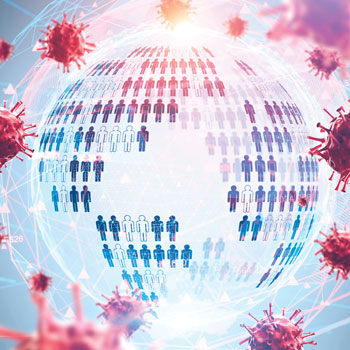Looking at ‘long COVID,’ five years later
An expert explains progress and knowledge gaps related to postacute sequelae of COVID-19, also known as long COVID.
It may seem like the isolation mandates and global disruption of the COVID-19 pandemic were just yesterday, but 2025 marks five years since the SARS-CoV-2 outbreak took hold in the United States.
Now that the virus is endemic, it has moved to the back of most Americans' minds. But for those living with postacute sequelae of COVID-19, or long COVID, however, the illness is anything but forgettable. The latest available CDC data show that in August 2024, 5.3% of adult Americans reported they were currently experiencing long COVID.

To learn more about what progress has been made in understanding long COVID and which knowledge gaps still exist, I.M. Matters spoke with ACP Member Linda N. Geng, MD, PhD, the co-director of the Stanford Long COVID Collaborative and the Stanford Long COVID Clinic in California. Dr. Geng is also an investigator for the federal RECOVER (Researching COVID to Enhance Recovery) Initiative and served on the Department of Health and Human Services' Advisory Committee on Long COVID.
Q: How has experts' understanding of long COVID evolved?
A: We've definitely learned a lot over the years, but there's still much to learn. First of all, we know clearly that it is a real disease with biological causes. We're still working out what some of those specific mechanisms are, but there's been a lot of research to highlight some of the biological pathways that might be at play.
Second, it is now clear that it can be a chronic illness for some. We now know, unfortunately, that it can last for years, and we don't know if or when it might end for some who continue to suffer. Some people do get better, but again, it is a chronic condition.
And then third, we do have more clarity on the vast array of symptoms and manifestations that people with long COVID can experience. It's more appropriate now to reframe long COVID as an umbrella term, meaning that it encompasses many different subtypes or sub-conditions, rather than just being one entity. Long COVID isn't just one thing, but it's multiple different things that are an infection-associated chronic condition.
Finally, … we know long COVID fits under or within this broader category of infection-associated chronic conditions, and there's some overlap with other conditions in this category, and possibly also common biological mechanisms. This is important because it brings to light a neglected area of medicine. Hopefully, what we learn about long COVID we can apply to some of these other conditions, and what we have learned from these other conditions we can leverage for long COVID.
Q: What factors are associated with developing long COVID?
A: I want to emphasize and underscore that long COVID can affect anyone, no matter age, race, sex, et cetera, but there are a variety of factors that have been shown to potentially increase someone's risk, such as not being vaccinated against COVID-19. Multiple studies have shown that there seems to be a protective effect against developing long COVID if you get vaccinated. Also, different variants have different risk rates. It seems like earlier variants of SARS-CoV-2 maybe have had increased risk of long COVID. But the virus continues to change. It's to be determined what future variants might do.
There seems to be a predominance towards the female sex. We see about a roughly two-to-one, or 60% to 70%, roughly, female versus male [prevalence]. But again, it can impact anybody. Some other risk factors include higher [body mass index], smoking status, and certain medical conditions like diabetes, asthma, [and] immunosuppression.
Q: Are there racial/ethnic disparities in rates of long COVID?
A: This is an important area that really needs to be studied further. It's clear that the pandemic itself has exacerbated health disparities, and communities of color were disproportionately impacted by COVID in many different ways. That is an important thing to note, and the racial/ethnic disparities in the rates of long COVID, in particular in different regions and communities, still need to be further studied. There have been data from health agencies and some large studies to suggest there are higher rates of long COVID in Hispanic and Black populations. But again, this might be regional … the populations who are disproportionately impacted by acute COVID therefore may have sequelae or subsequent adverse outcomes from COVID as well.
Q: How do you diagnose long COVID? Are there any definitive symptoms, biomarkers, or diagnostic tests?
A: Diagnosis can definitely be a challenge, given the lack of concrete and specific clinical guidance, but we have made steps forward. In 2024, the National Academies of Science, Engineering and Medicine put forth a definition of long COVID that helps to provide a starting framework. It's not very specific, but it helps anchor a post where clinicians can start. It helps us begin to make progress where we can standardize approaches to services, to clinical care, and research as well, and policies.
Of course, there will be refinement as we learn more. The next step for clinicians in particular is then the deeper classifications of the subtypes, and management strategies and other classification criteria. … I do want to make the point that symptoms can highly vary among different people, and there are no definitive symptoms, but there are some more common symptoms than others, such as fatigue, postexertional malaise, and cognitive changes. Common symptoms can help clinicians pattern-recognize, but again, people can have different symptoms from these as well.
Currently in clinical practice, there are no validated biomarkers or tests that are diagnostic for long COVID. Certainly, there's an urgent need to find these so that we can help aid in diagnosis, prognosis, and also treatment monitoring.
Q: How should primary care physicians manage long COVID?
A: There is now a growing number of continuing medical education and other educational resources to help train and support [primary care physicians] to take care of patients with long COVID. Our Stanford Long COVID program is part of the national [Agency for Healthcare Research and Quality] Long COVID Care Network that aims to build additional tools and resources to support primary care clinicians and other clinicians in diagnosing and managing long COVID.
I encourage clinicians to learn more about long COVID through these educational tools, CME, and pathways. [The American Academy of Physician Medicine and Rehabilitation] has also published several consensus guidance statements to help clinicians address common manifestations of long COVID, such as fatigue or cognitive dysfunction, autonomic dysfunction, et cetera.
It's important to remember that care plans and treatment plans are individualized and tailored to the complexities of this umbrella condition. … Right now, we're lacking a currently established, evidence-based treatment or a cure for long COVID.
Q: How can primary care physicians counsel their patients about long COVID? What can patients expect as far as recovery?
A: Some of the things that we mentioned earlier about what long COVID is [may] help patients also wrap their heads around “What is this thing that I'm experiencing?” Validating their experiences, and then [recommending] healthy lifestyle choices that can help support some of the things that we think might be affected by long COVID, like the immune system, brain health, and quality sleep, [may also help]. Anything we can do to help boost our own body's recovery state while we try to find treatments in supportive ways is important.
It is important, though, to note that if patients have something called postexertional malaise, where they feel worse after they exert themselves, clinicians should counsel about pacing and not push exercise or return to activity too much.
Recovery really varies, and the trajectory can too. Some people have linear courses, where they have gradual improvement over time. Some people can have gradual worsening, while others experience ups and downs. And that's actually a common pattern with flares and remissions or good days or good weeks mixed with bad days or bad weeks. Additionally, there's a spectrum of severity: Some people may have one or two mild symptoms and still be able to function, whereas another may have dozens of symptoms and be bedbound. Many people, especially with milder long COVID and still within the first six months post-COVID, do get better, and so I do like to offer some optimism or hope.
Q: What complications can arise from long COVID, if any?
A: On a practical level, the biggest complication that arises from long COVID … is the functional debilitation and the disability. Some people with long COVID are unable to live their lives, are not able to work, go to school, care for themselves or their families. This is the biggest universal complication that comes from severe long COVID that's protracted.
Q: Are there any myths or assumptions about long COVID that you would like to dispel?
A: Definitely. I want to underscore that for the whole category of infection-associated chronic conditions, such as long COVID and other conditions like it, they're puzzling. They're complex and poorly understood, and people may appear well on the outside or on lab tests that are currently clinically available, but they're severely suffering on the inside. Because of that and other reasons, there's been an associated stigma or wrong assumption by some that it isn't “real” or that it's all in somebody's head.
But this is definitely not imaginary. We need to learn from the history of medicine—there have been other conditions or other diseases for which we didn't initially know the biological mechanism. Decades or centuries later, it became clear what the underlying biology was, and therapies were developed. I want to dispel the myths: People aren't just lazy. People aren't crazy. This is real, and hopefully it won't take centuries or decades to fully understand long COVID.
What we can definitely start doing today, especially clinicians who are taking care of individuals with long COVID, is to validate their experiences, listen and support our patients. We can do simple things like tell people, “I believe you.”




